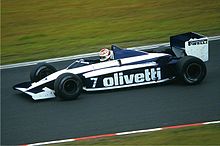Gordon Murray
Gordon Murray (born June 18, 1946 in Durban , South Africa ) is a South African engineer and former racing car designer in Formula 1 .
Career
The way to England
Murray grew up in Durban as the son of a car mechanic . After school and military service, he studied at Natal Technical College , now the University of Technology Durban , mechanical engineering . During his studies, Murray designed, built and drove his own racing cars and engines.
Since Murray saw no future for his racing ambitions in South Africa, he went to Lotus in England in the hope of a job . There, however, a chance encounter with Ron Tauranac earned him a job at Brabham . He worked there for three years at Tauranac's side as a design engineer and when Bernie Ecclestone took over the team, Murray became assistant to chief designer Ralph Bellamy . At the end of 1972 Ecclestone promoted him to technical director.
Brabham
The first Formula 1 car developed by Murray was the Brabham BT42, which was driven by Carlos Reutemann and Wilson Fittipaldi in the 1973 season . Brabham finished fourth in the constructors' championship. In 1974 , Reutemann won three races with the further developed BT44 . In 1975 , with the BT44B, Reutemann and Carlos Pace each won a race and took second place in the constructors' championship. Murray wanted a flat 12-cylinder engine with a 180 ° cylinder angle for 1976 in order to be able to improve the aerodynamics. Ecclestone hired Alfa Romeo to build such an engine, which was used in the BT45. However, the car did not work as expected and Reutemann left the team in the middle of the season. The redesigned car for 1977 brought an improvement, but the Alfa engines were not reliable.
In 1978 the BT46B , which became famous as the “vacuum cleaner” car, was used. A large fan sucked the air from under the vehicle, creating a vacuum that pressed the car onto the road. Niki Lauda won the Swedish Grand Prix with it , but the car was declared illegal by the FIA shortly afterwards .
When the floor-effect vehicles began to take hold, Murray needed a differently designed engine to make the vehicle underbody aerodynamic. Alfa built a new V12 that was used in the less successful BT48. Murray then built the BT49, which was powered by a Cosworth engine. Nelson Piquet was able to win three races in 1980 and the world championship in 1981 .
From 1982 Brabham drove with BMW turbo engines. Piquet won the Canadian GP in the BT50 and again the world title in 1983 in the BT52. In the following years, Murray's car won a few races, but could no longer build on the successes of the early 1980s. For 1986 Murray developed his last Brabham, the BT55 with a flat BMW turbo, in which Elio de Angelis had a fatal accident during test drives.
McLaren
Murray joined McLaren in late 1986 . The McLaren Honda MP4 / 4 developed by Steve Nichols , which won 15 of 16 races in 1988 , was based on Murray's concept of extremely flat construction, which he had already implemented in the Brabham BT55 . After this season, Neil Oatley took over the development department and Murray moved to a managerial position at McLaren Automotive , where he developed the McLaren F1 in 1989 as head of design . On this project he worked again with Paul Rosche , who had already developed the BMW turbo for Brabham and was now responsible for the 6.1-liter engine used in F1.
Gordon Murray Design
Murray stayed with McLaren until early 2005, when he went into business for himself. In July 2007 he presented his plans for a new road vehicle concept to the public, which he developed with his company Gordon Murray Design . The car should be small, light, low in pollutants and unconventional. As with the McLaren F1, a key element of the design should be particularly sophisticated "packaging". In Murray's view, the arrangement of the assemblies and the division of the floor space have a far greater influence on the capabilities of a car than technical details. The vehicle called T.25 was presented to the public in June 2010. The electrically powered version of the vehicle is called T.27.
In August 2020, the company presented a super sports car, the T.50 , which is also known as the “spiritual successor” of the McLaren F1. Series production of the vehicle, which is limited to 100 examples, is scheduled to start in January 2022. It is powered by a 488 kW (663 hp) four-liter V12 petrol engine at 11500 rpm . The maximum speed of the naturally aspirated engine should be 12,100 rpm. The maximum torque of 467 Nm is achieved at 9,000 rpm, 71% of which at 2500 rpm.
Web links
Individual evidence
- ^ McLaren time line 1980s: 1988 ( Memento June 10, 2008 in the Internet Archive )
- ↑ Matthew Knight: Former F1 engineer unveils new city car , CNN.com, June 29, 2010, accessed April 19, 2012
- ↑ Roland Hildebrandt: Gordon Murray Automotive T.50: Superfast vacuum cleaner. In: de.motor1.com. August 4, 2020, accessed August 4, 2020 .
| personal data | |
|---|---|
| SURNAME | Murray, Gordon |
| BRIEF DESCRIPTION | South African engineer and racing car designer in Formula 1 |
| DATE OF BIRTH | June 18, 1946 |
| PLACE OF BIRTH | Durban , South Africa |



